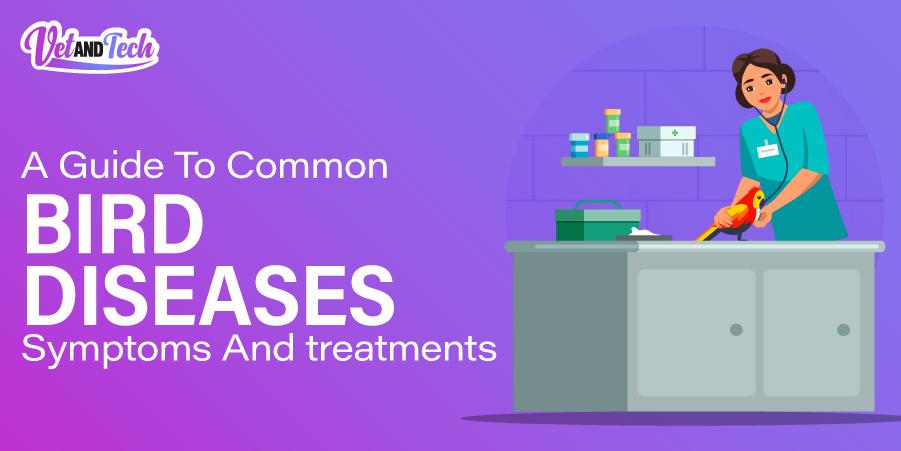A Guide To Common Bird Diseases–Symptoms And Treatments
Birds can make excellent pets. However, it can be upsetting when your feathered friend shows signs of illness and isn't as cheerful as usual. Recognizing common pet bird diseases and learning about the best treatment options can be beneficial. Besides, bird parents who are knowledgeable about bird health and disease can ensure that their bird lives a long and happy life.
As a bird owner, you should have a basic knowledge of diseases’ symptoms for a timely diagnosis of any condition in your bird. Early illness detection is critical to the successful treatment of pet birds. As a result, it is essential to comprehend some of the most common diseases that affect birds.
In the following, we have enumerated various bird diseases and symptoms to assist you in finding a healthy bird.
Bird Diseases and Their Symptoms
Infections by viruses, bacteria, and fungi are common in birds. However, sometimes conditions like these may go unnoticed if there is no significant change in your bird’s behavior. However, as a bird owner, you have to be very vigilant regarding even a slight change in your bird’s behavior and take necessary action.
In the following, we have listed a few bird diseases that pet owners should be aware of in case of infection.
Parrot Fever
Parrot fever also goes by the names psittacosis, chlamydiophila psittaci, and ornithosis. It is an infectious disease that frequently affects many bird species. It usually spreads through contact with bird droppings and dust. This bacterial infection is highly contagious among pet birds.
Symptoms
The symptoms of bird fever are as follows:
• Lack of appetite
• Difficulty breathing
• Depression
• Watery, green droppings
• Discharge from the eyes and nose
Treatment
Parrot fever necessitates antibiotic treatment under the proper care of your avian vet and use of multivitamin for parrots for preventing nutrient deficiencies.
Avian Pox
Avian pox is a viral skin infection that causes warty growths on infected birds' heads, legs, wings, or other body parts. Affected birds feed and fly like normal. The virus is relatively resistant and can survive for a long time on contaminated surfaces. Maintain optimal hygiene in areas where an avian pox virus outbreak exists. Clean out birdbaths daily, and refill them with fresh water. It spreads through direct bird-to-bird contact and indirect contact through perches or bird feeders.
Symptoms
The affected birds show the following symptoms:
• Have grey, pinkish, red, or yellow color growths.
• Smaller brown or gray lesions.
• Blisters on unfeathered parts of the skin
• Weakness
• Difficulty in swallowing and breathing
• Vision problems
• Soiled facial feathers
• Conjunctivitis
Treatment
Supportive care, fluids, parenteral vitamins, ophthalmic ointments for eye infections, assisted feedings, and antimicrobials to prevent secondary infections are common treatments.
Polyomavirus in Birds
Avian polyomavirus is another infectious disease found in birds. It is a very deadly virus that often affects younger birds. Some studies have indicated that adult birds may develop immunity. The infection spreads through the dander of birds, their droppings, and contact with the birds.
Symptoms
The bird may take some time to show signs of polyomavirus infection. These symptoms are:
• Swollen abdomen
• Loss of appetite
• Vomiting or diarrhea
• Weight loss
• Dehydration
Treatment
Vaccination against polyomavirus is available and should be performed early. An infected bird has no known treatment. Therefore, strict hygiene and limiting contact between potentially infected birds are the best preventative measures.
Salmonella
Salmonella infection can cause ruffled feathers, swollen eyelids, and lethargy in birds. It is primarily transmitted by fecal contamination of food and water, but it can also be transmitted by birds interacting with one another. Symptomatic birds usually die within three days. Salmonellosis is a bacterial infection found in low numbers in wild bird populations. Salmonella outbreaks in wild birds have been observed during the winter months.
Symptoms
There are no symptoms specific to salmonella, but infected birds will show general sickness signs. For example, they:
• Look listless and lethargic
• Tend to stay close to feeders
• Fail to respond to danger
• Become weak and emaciated
Treatment
No medical treatment is known to cure birds infected with Salmonella bacteria completely. However, bacterial antibiotics can protect the patient from other diseases.
Candidiasis
Candidiasis, also known as thrush, is characterized by white lesions in the mouth and throat. Due to difficulty swallowing, appetite loss is quite common. This illness is caused by a yeast infection and is typically treated with antifungal medication and cleaning the environment, particularly the food and water dishes.
Symptoms
The symptoms of candidiasis in birds are as follows:
• Lethargy
• Fluffed feathers
• Little to no appetite
• Vomiting
• A distended crop full of mucus
Treatment
Antifungal drugs are used for the treatment of candidiasis in birds. Your vet will prescribe the medication dose accordingly for your bird.
Conclusion
These are just a few diseases that can affect pet birds. Hence, bird owners should thoroughly research other illnesses and health conditions that may be a problem for their specific pet bird species. If your bird is experiencing health issues, always consult a veterinarian immediately. Nonetheless, it is best to keep your knowledge up to date to avoid diseases.
You may reach out to our veterinary resources if you need information regarding bird diseases. Vet and Tech contain information on common animal diseases that can broaden your knowledge. Learn about diseases and how to keep yourself and your birds healthy through our resource on common diseases.
Frequently Asked Questions
How to recognize a sick bird?
A sick bird can be identified by its poor general appearance, fluffed feathers, changes in eating habits, or decreased appetite. They also exhibit weakness, drooping wings, listlessness, inactivity, and depression.
Can dirty cages make birds sick?
Dirty cages can cause a variety of serious health issues in birds. Certain cleaning must be done daily to reduce your pet's risk of infection.
Why do birds conceal their illnesses?
You may not realize the birds' sickness until their illness or pain worsens. This is because birds conceal their illnesses and pain as a survival strategy to avoid appearing weak and becoming an easy target for predators.








